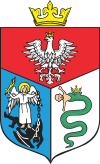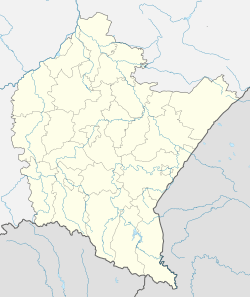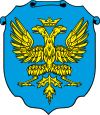Sanok
Sanok [ˈsanɔk] (in full the Royal Free City of Sanok - Polish: Królewskie Wolne Miasto Sanok, Ukrainian: Cянік Sianik, Latin: Sanocum, Yiddish: סאניק, Sonik) is a town in the Subcarpathian Voivodeship of south-eastern Poland with 38,397 inhabitants, as of June 2016.[1] Located on the San River and around 52 km south of Przemyśl, Sanok lies directly by the Carpathian Mountains.
Sanok | |
|---|---|
| Królewskie Wolne Miasto Sanok Royal Free City of Sanok | |
Town panorama with the Cathedral and the Carpathian Mountains in the background. | |
 Flag  Coat of arms | |
| Motto(s): Libera Regia Civitas Free Royal City | |
 Sanok  Sanok | |
| Coordinates: 49°33′N 22°13′E | |
| Country | |
| Voivodeship | |
| County | Sanok County |
| Gmina | Sanok (urban gmina) |
| Established | before 12th century |
| Town rights | 1339 |
| Government | |
| • Mayor | Tomasz Matuszewski |
| Area | |
| • Total | 38.15 km2 (14.73 sq mi) |
| Population (2016) | |
| • Total | 38,397[1] |
| Time zone | UTC+1 (CET) |
| • Summer (DST) | UTC+2 (CEST) |
| Postal code | 38-500 |
| Area code(s) | +48 13 |
| Car plates | RSA |
| Website | http://www.sanok.pl |
Once settled by Poles, Jews and Lemkos, the town's history goes back almost 1000 years when it was part of a medieval trade route.[2] The Museum of Folk Architecture as well as the refurbished Sanok Castle and Old Town are popular points of interest.[3] The region also features a 70 km trail for hikers and cyclists.[3]
Geography
It is the capital of Sanok County in the Subcarpathian Voivodeship. Previously, it was in the Krosno Voivodeship (1975–1998) and in the Ruthenian Voivodeship (1340–1772), which was part of Red Ruthenia and, in wider sense, of the Lesser Poland Province of the Polish Crown (not of Lesser Poland proper). Historically it was part of the Land of Sanok and the Ruthenian Voivodeship.
This historic city is situated on the San River at the foot of Castle Hill in the Lesser Poland (Małopolska) region. It lies in a wooded, hilly area near the national road number 28, which runs along southern Poland, from Ustrzyki Dolne to Wadowice (340 km or 211 mi away). It is located in the heartland of the Pogórze Bukowskie part of Doły (Pits), and its average elevation is 300 m (984 ft) above sea level, although there are some hills located within the confines of the city.
Sanok is located on the bank of the river San. The area surrounding mountain range stretches between the Wisłok, Osława and San Rivers in the Salt Mountains (Central Beskidian Piedmont), in the inland with temperateness climate. The hills of the Bieszczady mountain range are typical for this countryside. Sanok County is bordered by Krosno County to the west, Brzozów County to the north, Przemyśl County to the north-east and Lesko County to the east. It also borders Slovakia to the south. Before World War II, the Oslawa and San Rivers line was designated the wild frontier between Poles and Lemkos.
The city is a member of Carpathian Euroregion, which is designed to bring together the people who inhabit the region of the Carpathian Mountains and to facilitate their cooperation in the fields of science, culture, education, trade, tourism and economy.
History
In 981 the gord, then inhabited by the Slavic tribe of Lendians, was made a part of Land of Czerwień. This area was mentioned for the first time in 981, when Vladimir I of Kiev took the area over on the way into Poland. In 1018 it returned to Poland, 1031 back to Rus', in 1340 Casimir III of Poland recovered it. The gord of Sanok in mentioned for the first time in Hypatian Codex in 1150. It was given the Magdeburg law by Boleslaw-Yuri II of Galicia in 1339.[4]
In a Ruthenian chronicle can be found the Hypatian Codex, where at the date of 1150 one can read: The Hungarian King Géza II of Hungary crossed the mountains and seized the stronghold of Sanok with its governor as well as many villages in the Przemyśl area. The same chronicle refers to Sanok twice more, stating that in 1205 it was the meeting place of a Ruthenian princess Anna and a Hungarian king and that in 1231 a Ruthenian prince made an expedition to "Sanok - Hungarian Gate".
After 1339 Galicia–Volhynia was seized by King Casimir III of Poland, who reconfirmed the municipal status of Sanok on 25 April 1366. At that time Sanok became the centre of a new administrative district called Sanok Land, a part of the Ruthenian Voivodeship. Several courts of justice operated in the town, including the municipal and rural courts of lower instance and also the higher instance court for the entire Sanok Land, based on the German town law.[5] Germans settled in the territory of the Kingdom of Poland (territory of present-day Subcarpathian Voivodeship) from the 14th to 16th centuries (see Ostsiedlung), mostly after the region returned to Polish sphere of influence in 1340, when Casimir III of Poland took the Czerwień towns.
Marcin Bielski states that Bolesław I the Brave had settled some Germans in the region to defend the borders against Hungary and Kievan Rus', who later turned to farming. Maciej Stryjkowski mentions German peasants near Przeworsk, Przemyśl, Sanok, and Jarosław, describing them as good farmers. The region was also traditionally inhabited by subgroups of the Rusyn people: Lemkos and Boykos.
As early at the 17th century, an important trade route went across Sanok connecting the interior of Hungary with Poland through the Łupków Pass. As a result of the first of Partitions of Poland (Treaty of St-Petersburg dated 5 July 1772, Sanok was attributed to the Habsburg Monarchy.[6] At that time the area (including west and east of Subcarpathian Voivodship) was known as the Galicia province. For more details, see the article Kingdom of Galicia and Lodomeria.
In the mid-18th century, 47.7% of the town's population was Roman Catholic (Polish), 36.4% Jewish, and 14.7% Greek Catholic (Ruthenian).[7]
The Galician peasant revolt took place in the region during the revolutions of 1848.
The course of the river Dunajec and that of the San, both in West Galicia, marked the two successive stages in the breakthrough battle which initiated the Austro-German offensive of 1915 on the eastern front. An attempt to hold the line of the Wisłok river and the Łupków Pass failed before renewed Austro-German attacks on 8 May 1915. Wisłok Valley was one of the strategically important Carpathian rivers bitterly contested in battles on the Eastern Front of World War I during the winter of 1914–1915.[8]

During World War I, the Russian army occupied the town from May until July, 1915 and significantly damaged the town. The town was subsequently occupied by troops of the Austro-Hungarian Empire.
During the Second Polish Republic (1919–1939), Sanok was known as a centre of Ukrainian movement in Galicia, and of cultural heritage of the Lemkos and other Rusyns.
The Jewish population of Sanok may have been almost 30% for many years in the early 20th century. At the beginning of the Nazi occupation, the Jewish population was around 5000. With the advent of the Nazis and with anti-semitism in Galicia, most of the Jews were either executed or killed in Nazi death camps or Nazi concentration camps during the Holocaust. Some of the actions against the Jews were assisted by Ukrainian auxiliaries and hundreds of the deaths occurred in Sanok itself.[9] Buildings that had been owned by Jews were taken by the local population. The local Jewish cemetery still exists. Several hundred Jews are thought to have survived, most of whom fled to the Soviet Union at the beginning of the war. Some of the Jews emigrated to Canada and the United States in the early 1900s with Sanoker Burial Societies spreading throughout New York and other regions where they settled.
In 1943 the foundation of the Waffen-SS Division Galizien took place in heavily Ukrainian-populated Sanok, with many locals volunteering in the ethnic Ukrainian Waffen-SS. Because of material support and assistance provided by the local population to the Ukrainian Insurgent Army, which was waging a battle for Ukrainian separatism against the Polish state, Polish authorities deported the Ukrainian and Lemko population of Sanok and its region to the former eastern territories of Germany attached to Poland after World War II (the so-called Recovered Territories) during Operation Vistula (1946–1947). Some the Lemkos expelled returned to Sanok in 1957-58 and others after 1989.
Sanok contains an open-air museum called a skansen in the Biała Góra district, where examples of architecture from all of the region's main ethnic groups have been moved and carefully reassembled in a skansen evoking everyday rural life in the 19th century.
Archaeology

Settled in prehistoric times, the south-eastern Poland region that is now Subcarpathia was overrun in pre-Roman times by various tribes, including the Celts (Anarti), Goths and Vandals (Przeworsk culture and Púchov culture). After the fall of the Roman Empire, of which most of south-eastern Poland was part (all parts below the San)[<What is the evidence for this last assertion? There do not appear to be any documented Roman marching camps of forts, or settlements], the area was invaded by Hungarians and Slavs.
The region subsequently became part of the Great Moravian state. Upon the invasion of the Hungarian tribes into the heart of the Great Moravian Empire around 899, the Lendians of the area declared their allegiance to Hungarian Empire. The region then became a site of contention between Poland, Kievan Rus' and Hungary starting in at least the 9th century.
The first traces of settlement in the area of modern Sanok date back to at least the 9th century. The following century a Slavic fortified town (gord) was created there and initially served as a center of pagan worship. The etymology of the name is unclear, though most scholars derive it from the Celtic river-name San.[10][11][12] Certain archaeological excavations performed on the castle hill and on Fajka hill near Sanok-Trepcza, not only confirm the written resources, but date the Sanok stronghold origin to as early as the 9th century. On Fajka hill, where probably the first settlement of Sanok was situated, some remains of an ancient sanctuary and a cemetery were found, as well as numerous decorations and encolpions in Kievan type. Also found were two seals of the Great Kievan Prince Rurik Rostislavich from the second half of the 12th century.
Sights

a.jpg)
- Skansen in Sanok - detailed houses, churches, cerkiews (Orthodox/Uniate churches of Lemkos, Boykos etc.)
- Sanok castle and Icon collection - one of the largest collections of this in Central and Eastern Europe.
- Town square/Rynek
- Parish Church dating to the 19th century
- Franciscan Church dating to the 14th century.
Near the central town square and the previous Jewish ghetto, there is a valley where much of the Jewish population was murdered en masse by the Nazis during the Holocaust.
Economy
e.jpg)
Sanok has a strong industry base - home to Stomil Sanok[13] (established in 1932) and Pass Gummiwerke plants, producers of various rubber and metal-rubber seals, strings and laggings for automotive sector, construction industries and electrical household goods sector, PGNiG[14] and Sanok Bus Car Factory "Autosan"[15] (established in 1832), a producer of high capacity buses, cabins for the Polish Army and bodies for rail-vehicles. Stomil is next to the main train station in Sanok and Autosan is a 10-minute walk from the station, while the town centre is a 15-minute walk in the other direction.
Culture and education

The town has several public schools and a branch of the Polish High School of Technology. The town also has a football club called Stal Sanok and some other sport clubs (including volleyball, swimming, handball, ice hockey). The Sanok Castle near the centre of the old town houses a museum displaying over 300 fine icons. The Museum of Folk Architecture is one of the biggest open-air museums in Poland and show cases 19th and early 20th century life in this area of Poland.
Sport
The city has two professional sports teams. The local ice hockey team is Ciarko PBS Bank STS Sanok,[16] which has won the Polska Hokej Liga league title twice, in the 2011/2012 and 2013/2014 season. They won the Polish Cup twice, in 2010-11 and 2011–12. The local football club is Stal Sanok, which most recently competed in the Polish Third League (4th level), in the 2013/14 season. The team is currently inactive due to financial reasons.
There many sports facilities in Sanok and the main complex of those facilities is The Civic Sports and Recreation Centre, situated near the San River. The Centre includes: the artificial speed skating oval Tor Błonie, a complex of indoor and outdoor swimming pools, a hotel, a tourist hostel, a camp-site, a sports stadium with technical facilities, etc. There is also another artificial ice rink in the centre of the town, designed for ice hockey and managed by the ice hockey club KH Sanok. There are two more sports facilities at Stróżowska street: a stadium of sports club Stal Sanok, and a gymnasium of the Technical Schools Complex.
In winter, a ski-lift operates in the nearby Karlików.
Notable people
- Katarzyna Bachleda-Curuś (born 1980), speed skater
- Tomasz Beksiński (1958–1999), radio presenter
- Zdzisław Beksiński (1929–2005), painter, photographer, sculptor
- Adam Fastnacht (1913–1987), Polish historian
- Jan Grodek (?–1554), nine-time rector of Jagiellonian University
- Shlomo Halberstam (1847–1905), first Bobover Rebbe
- Mikołaj Kamieniecki(1460–1515), nobleman
- Juliusz Kühl (1913–1985), Polish diplomat
- Piotr Michalski (born 1994), speed skater
- Jerzy Mniszech(c. 1548–1613), nobleman
- Ryszard Pacławski (born 1958), lawyer
- Marian Pankowski (1919–2011), resistance fighter of World War II
- Zdzisław Peszkowski (1918–2007), survivor of the Katyn massacre
- Meir Shapiro (1887–1933), first Orthodox Jew to become a member in the Sejm (Parliament)
- Kazimierz Świtalski (1886–1962), politician and diplomat
- Tadeusz Vetulani (1897–1952), agriculturalist and biologist
- Frank-Wojnarowski (1921–1966), American Polish Orchestra leader
Demographics
| Year | Pop. | ±% p.a. |
|---|---|---|
| 1589 | 1,700 | — |
| 1883 | 5,181 | +0.38% |
| 1900 | 6,123 | +0.99% |
| 1939 | 15,600 | +2.43% |
| 2000 | 41,401 | +1.61% |
In the mid-18th century, Roman Catholics constituted 48.7% of the population, people of Jewish faith 36.5%, and 14.7% of the inhabitants belonged to the Greek Catholic Church.[17]
In 1900, the town had 6123 inhabitants, 57% Polish, 30% Jewish of various ethnicities (Boyko, Lemkos, Rusyn, Ruthenians etc.), and others. The town's large population of Jews were almost all murdered during the Holocaust.
- Ethnic Groups
See also
- Folk Dance Ensemble Sanok
- Great Moravia
- Kingdom of Galicia and Lodomeria
- Lendians
- List of towns with German town law
- Lwów Voivodeship
- Ostsiedlung
- Pogórzanie
- Rural Architecture Museum of Sanok
- Ruthenian Voivodeship
- The Petroleum Trail International Tourist Trail
- Walddeutsche
References
- "Sanok » mapy, nieruchomości, GUS, szkoły, kody pocztowe, wynagrodzenie, bezrobocie, zarobki, edukacja, tabele". www.polskawliczbach.pl. Retrieved 20 June 2017.
- "History of the town « Oficjalna strona Miasta Sanoka". www.sanok.pl. Retrieved 20 June 2017.
- o.o., StayPoland Sp. z. "Sanok - Tourism - Tourist Information - Sanok, Poland -". www.staypoland.com. Retrieved 20 June 2017.
- "City privilege in latin in:] Digitalbibliothek of AGAD, Nr 7226". Archived from the original on 31 October 2008. Retrieved 20 June 2017.
- "Thus the region adjoining the Carpathians and extending to a line Tarnów–Rzeszów–Jarosław, the hithero almost uninhabited regio pedemontana was settled by German-speaking Silesians and soon abounded in large Waldhufendorfer with Frankish hides and in towns whose German names were in many case identical with place-names in Silesia (Landskron, Grunberg, [...] Göttinger Arbeitskreis. Eastern Germany. Holzner-Verlag, 1961. p. 79.
- Atlas des peuples d'Europe centrale, André et Jean Sellier, 1991, p.88
- Motylkiewicz, Jerzy (2005). "Ethnic Communities in the Towns of the Polish-Ukrainian Borderland in the Sixteenth, Seventeenth, and Eighteenth Centuries". In Hann, C. M.; Magocsi, Paul R. (eds.). Galicia: A Multicultured Land. University of Toronto Press. p. 37. ISBN 978-0802037817.
- "The Pursuit and Battles at Sanok and Rzeszów (May 6).—After his severe defeat, Radko Dimitriev's plan was to hold the Łupków Pass with his left wing, and, supported upon this, to bring the pursuit to a stand on the line Nowotaniec–Besko-right bank of the Wisłok, where there were positions favoured by the lay of the ground, and then, between the Vistula and the Wisłok, on the line Wielopole-Rzeszów–Mielec. Here he proposed to reconstitute his units, which had fallen into great disorder, and to strengthen them by bringing up reserves.
Troops were sent to him from other fronts, and by the 8th he could again dispose of 18 inf. divs., 5 cav. divs. and 5 Reichswehr bdes. The orders were that the offensive was to be continued with all possible vigour. Mackensen's army was to push forward over the stretch of the Wisłok between Besko and Frysztak on Mrzygłód and Tyczyn, and the Archduke Joseph Ferdinand on Rzeszów, while Boroevic was to roll up Brussilov's VIII. Russian Army in the direction of Sanok. Bohm's II. Austrian Army was to join up corps by corps from the left wing in proportion to the progress of the attack."

- Megargee, Geoffrey (2012). Encyclopedia of Camps and Ghettos. Bloomington, Indiana: University of Indiana Press. p. Volume II 569–571. ISBN 978-0-253-35599-7.
- "Puisqu'il est impossible de les enumerer tous citons moins: Brda, Brenna, Bzura, Drwęca, Mroga, Nida, Raba, San, etc. Bzura selon Jan Rozwadowski correspond avec Brigulos, Drwęca aves Druentia, Durance, Nida avec Nidder, Raba avec Raab, San avec Sadne et Seine." [in:] Ethnologia Polona. Instytut Historii Kultury Materialnej (Polska Akademia Nauk). 1981. p. 49.
- "[...] San (lateinische Graphie wie bei Sandomierz, Santok usw. Vgl. altind. sindhu- "Fluß", den irischen GN Shannon und den Maizzufluß Sinn" [in:] Irena Kwilecka. Etnolingwistyczne i kulturowe związki Słowian z Germanami. Instytut Słowianoznawstwa PAN. 1987. ISBN 83-04-02472-1 S. 64.
- "An adouci en san, eau, rivière; stach, sinueux, qui tourne. Allusion au cours sinueux de la Charente". op. cit. Antiq. de France. [in:] Revue des études historiques. Société des études historiques. 1835. p.242.; Senne, nom propre de rivière. - Scène, ». Le lieu où l'on joue. — Seine, sf, sorte de «lot. 17. Cen», sm, impôt. — San, np Sen», sm, jugement [...]". [in:] Dictionnaire de pédagogie et d'instruction primaire. Ferdinand Edouard Buisson. 1883. p. 980.
- Agencja Interaktywna Internet Designers. "Rubber Factor Stomil Sanok". Stomilsanok.com.pl. Archived from the original on 2013-02-23. Retrieved 2013-02-14.
- PGNiG S.A. Branch in Sanok is a forerunner of underground gas storing in Poland and currently is operating four underground gas storages of total working capacity of 705 MM standard cu.m
- "Sanok Bus Car Factory". Autosan.com.pl. Retrieved 2013-02-14.
- "KH Sanok (pl)". Sanok.hokej.sport24.pl. Archived from the original on 2012-11-22. Retrieved 2013-02-14.
- J. Motylkiewicz. "Ethnic Communities in the Towns of the Polish-Ukrainian Borderland in the Sixteenth, Seventeenth, and Eighteenth Centuries". C. M. Hann, P. R. Magocsi ed. Galicia: A Multicultured Land. University of Toronto Press. 2005. p. 37.
External links
| Wikimedia Commons has media related to Sanok. |
| Wikivoyage has a travel guide for Sanok. |


